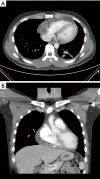Pericardial synovial sarcoma presenting with large recurrent pericardial effusion
- PMID: 27293869
- PMCID: PMC4885962
- DOI: 10.21037/jtd.2016.04.57
Pericardial synovial sarcoma presenting with large recurrent pericardial effusion
Abstract
Primary pericardial synovial sarcoma is an extremely rare disease with a dismal prognosis. Its main presenting symptoms are a large pericardial effusion, signs of cardiac tamponade, and visualization of a pericardial mass on echocardiography. However, the systemic symptoms of fever, cough, and night sweats may present a clinical picture without any apparent pericardial mass on diagnostic imaging, potentially impeding the diagnosis. We report the case of a 34-year-old patient with fever and recurrent pericardial effusion for 2 years, who was diagnosed with primary pericardial synovial sarcoma after 2-year follow-up echocardiography.
Keywords: Synovial sarcoma; heart; pericardial effusion; pericardium.
Conflict of interest statement
Figures





References
Publication types
LinkOut - more resources
Full Text Sources
Other Literature Sources
